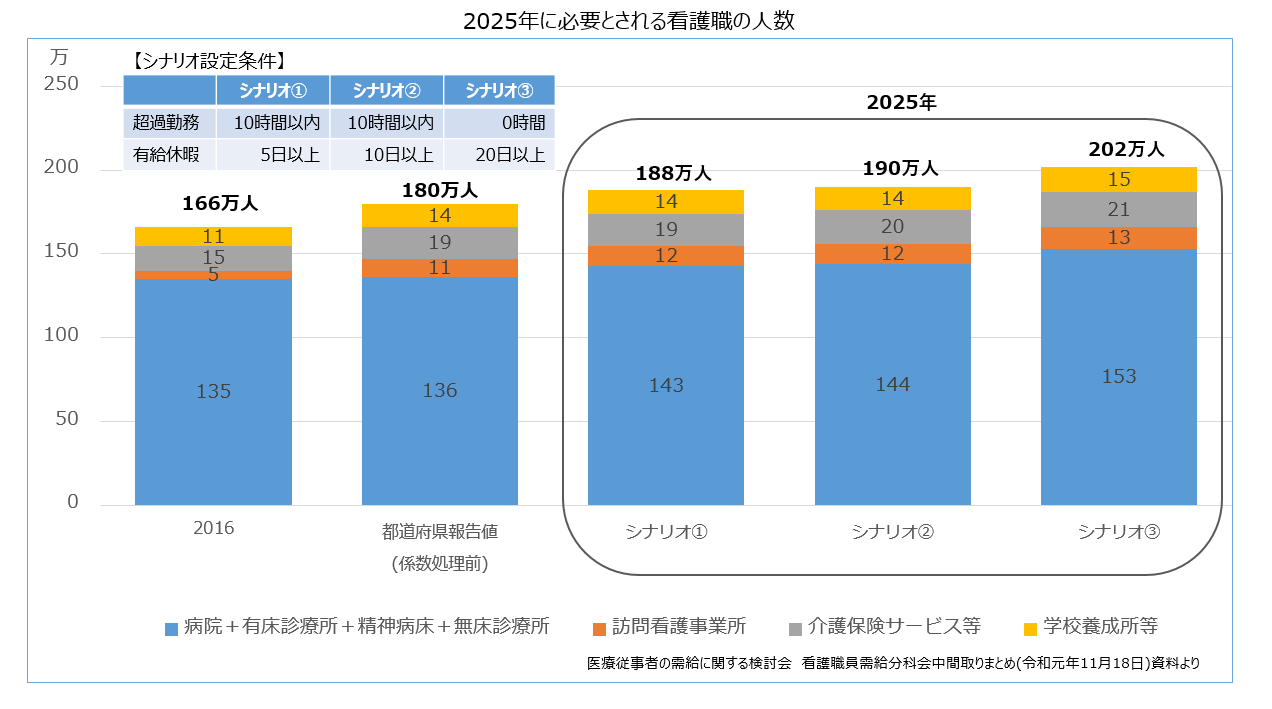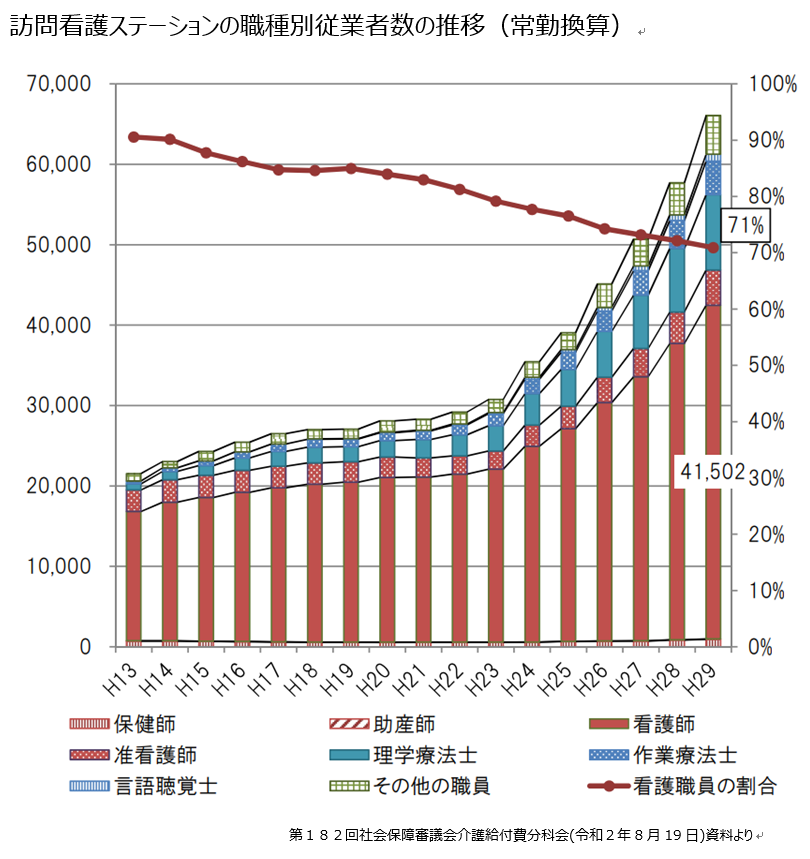
Release date: 2022.02.21
By 2030, one in three people in Japan is expected to be elderly. Against the backdrop of this aging society, the demand for care and nursing at hospitals, clinics, home-visit nursing homes, and nursing care facilities is only increasing. Along with this, the role of nurses who support recuperative life is becoming more and more important. Therefore, we will discuss the future prospects of nurses and the characteristics and roles of not only nurses but also nurses in two installments of ASOURCE NAVI.
In Japan, the aging society is steadily progressing. Demand for nursing care is expected to peak.
Against this background, the demand for nursing care and nursing is expected to increase in the future, and the need for nursing professionals is expected to increase. As of the end of 2020, the number of nursing staff, such as nurses and assistant nurses, is about 1.28 million, but by 2025 when the baby boomers reach the late-stage elderly, the number will only increase to between about 1.75 million and about 1.82 million. The Ministry of Health, Labor and Welfare has published an estimate that there will be a shortage of about 60,000 to a maximum of 270,000 people. In order to respond to this, the government is promoting efforts to secure nurses, such as increasing the enrollment capacity of nursing schools. In 2002, the enrollment capacity of nursing schools and training institutes was 53,800, but in 2018, it increased to 67,881. Nursing college enrollment has more than tripled over the same period. Along with this, the number of people who passed the national nursing examination increased from 44,137 in 2005 to 59,769 in 2021.

However, despite this situation, the shortage of nurses has been pointed out in recent years. Looking at the effective job openings multiple, the average for all occupations in February 2020 was 1.18, while nurses showed a high level of 2.24. This is because many women leave their jobs due to life stage changes such as marriage, pregnancy, childbirth, and childcare. According to a fact-finding survey by the Japanese Nursing Association, the turnover rate of regular-employed nurses in 2019 was as high as 11.5%.
Due to national medical policy, the number of hospital beds is being reduced and the length of hospitalization is being shortened, increasing the importance of recuperating at home after discharge. As a service to respond to such situations, there is a growing need for home-visit nursing, in which nurses visit patients' homes to provide nursing care. In home-visit nursing, based on the home-visit nursing instructions prepared by the attending physician, health status checks, recuperation guidance, medical treatment, and physical nursing are performed. Users range in age from infants to the elderly. There are a wide variety of medical departments, including internal medicine, psychiatry, neurology, and orthopedics. Most of the places where nurses engaged in home-visit nursing work are home-visit nursing stations. The number of home-visit nursing stations has increased rapidly since the fiscal 2012 revisions to medical and long-term care fees, and will reach approximately 13,000 in 2021. As of 2019, the number of nurses working at home-visit nursing stations has increased to approximately 55,000. It is estimated that the government will need 120,000 home-visit nurses by 2025 in order to promote the construction of a "comprehensive community care system" that allows people to receive medical care and nursing care in familiar areas.

As the number of elderly people increases, the demand for long-term care insurance facilities is increasing, and the role of nurses working there is becoming more and more important. According to the 2020 survey of long-term care service facilities, long-term care insurance facilities include 8,306 long-term care welfare facilities, 4,304 long-term health care facilities, 556 long-term care medical facilities (to be abolished in 2023), and 536 long-term care medical facilities. there is. A caregiver's main job is to support the overall life of residents in nursing homes, but nurses perform health management and medical care, such as checking the vitals of residents. In the case of nursing homes where doctors are not always present, nurses provide first aid in the event of a sudden change in a resident's condition, and take on the role of handing over the care to ambulance crews and doctors. Recently, it has also played a role in infection control to prevent the occurrence of new coronavirus infection clusters (groups of infected people) at nursing homes. As of 2019, there were 27,000 nurses working at health care facilities for the elderly, 26,000 at welfare facilities for the elderly, and 19,500 at social welfare facilities, and demand is increasing.
In addition, the future demand for nurses in community health centers and health care offices of private companies is expected to increase.
On the other hand, there is a demand for nurses who can practice high-level nursing in the medical field, where sophistication and specialization are progressing. Certified nurses are certified by the Japanese Nursing Association for each field of nursing. It is a qualification that can be obtained by having more than 5 years of practical experience as a nurse, completing more than 600 hours of certified nurse education set by the Japanese Nursing Association, and passing the certified nurse certification examination. As of July 2019, approximately 20,000 certified nurses are active nationwide. There are 21 fields identified as certified nursing fields, including "Emergency Nursing".
Certified nurses make judgments based on specialized knowledge and practice for patients and families who need difficult treatment and nursing. In addition, they provide guidance to other nurses on specialized knowledge and nursing techniques, encourage them to perform high-level nursing, provide consultation on problems and questions they face in the nursing field, and support them in deriving improvement measures. or In addition to hospitals, certified nurses work at home-visit nursing stations, clinics and clinics, and nursing care insurance facilities.
In 2015, the Japanese government established a system called "Training for Specified Acts" that allows nurses with expertise to assist in difficult medical care. We would like to renew the certification system in the form of a "specific certified nurse" that incorporates It is expected that there will be an increase in the number of nurses with high practical skills who will be able to provide appropriate treatment without waiting for the arrival of doctors, even when hospitalized or at home.
In addition, there are qualifications in more specialized fields, such as specialized nurses who are specialists in not only specialized fields but the entire nursing field, and clinical nurses who can perform a wider range of medical procedures than specified nurses.
Nursing qualification is not the goal, it is just the beginning. The job of a nurse who takes care of people's lives is physically and mentally hard, but it can be said that it is a profession that has many opportunities to feel more rewarding than others.
MEDIUS Group is developing a business centered on the sale of medical equipment. We (Medical + us) involved in medical care also want to play the role of an information source (Media) that delivers useful information for the medical field and people's healthy tomorrow.